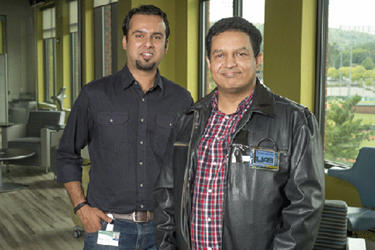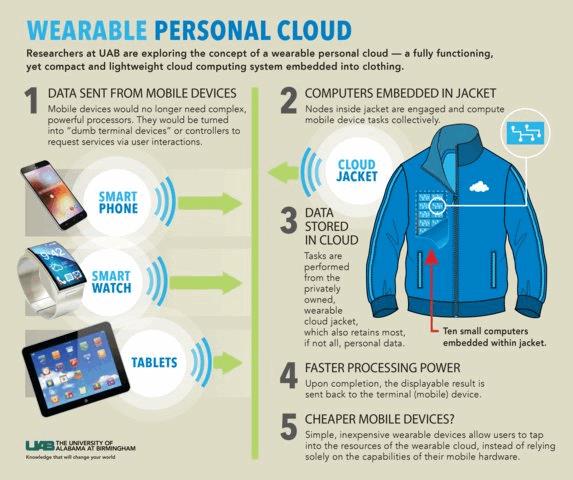Will The Wearable Cloud Emerge In Field Service?
By Brian Albright, Field Technologies
 |
| Rasib Khan and Ragib Hasan (wearing a prototype) of the University of Alabama demonstrated a new “wearable cloud” solution. |
Wearable technology has slowly been adopted in field service, including a few wearable computers and wearable video camera solutions. New research coming out of the University of Alabama at Birmingham may take the wearable concept to the next level – the creation of a wearable, personal cloud solution embedded into clothing.
The research team presented the prototype wearable “cloud jacket” at the 40th Institute of Electrical and Electronics Engineers Computer Society International Conference on Computers, Software & Applications (IEEE COMPSAC) earlier this summer.
The research team was led by Ragib Hasan, assistant professor of computer and information sciences in the UAB College of Arts and Sciences, and Rasib Khan, a postdoctoral graduate student. They integrated 10 open-source Raspberry Pi computers (which are roughly the size of a credit card) into a winter coat, along with three power banks and a small touchscreen display.
According to the researchers, the cloud jacket could take the place of (or enhance) multiple mobile devices (smartphone, smart watch, exercise tracker, etc.) by offering far more computing power and storage at a lower cost. The prototype jacket included 10 gigabytes of RAM (compared to the 1 to 3 gigabytes available on a phone), and 32 gigabytes of storage on each of the Raspberry Pi devices.

"Currently if you want to have a smart watch, smartphone, an exercise tracker and smart glasses, you have to buy individual expensive devices that aren't working together," Hasan said. "Why not have a computational platform with you that can support many forms of mobile and wearable devices? Then all of these capabilities can become really inexpensive."
Demands for more processing power and application support have pushed the limits of mobile device designers, and increased interest in the use of cloud resources for mobile apps, increasing the need for constant wireless connectivity. The wearable cloud could provide additional computing resources for other mobile devices using a Bluetooth or WiFi link. The technology could be integrated into other objects instead of clothing – a briefcase, backpack, toolbox, etc. Mobile devices like tablets or phones could be converted into “dumb” terminals that require less memory and processing power.
Hasan and Khan outlined a few potential applications, including use of this type of wearable infrastructure by firefighters and in hospital settings (where a wearable vest could monitor vital signs, eliminating the need for a tangle of wires connected to multiple devices).
But there is also some obvious field service applicability, particularly in applications where remote connectivity is difficult (or non-existent) and where technicians need to be able to access detailed schematics, videos, or diagnostic applications. Combined with a heads-up, wearable display or smartglasses, this type of solution could provide a platform for hands-free, augmented reality (AR) solutions that allow technicians to view schematics or instructions overlaid on the actual piece of equipment they are repairing.
Technicians working in highly remote areas with no wireless connectivity could carry a whole database of customer information and repair procedures without the need for a tablet or laptop. Combined with wearable sensors, the wearable cloud could even monitor and report on safety conditions, such as the presence of toxic gases in a workspace or a technician’s vital signs.
You can read their research paper, “A Cloud You Can Wear: Towards a Mobile and Wearable Personal Cloud,” here.
Source: University of Alabama
